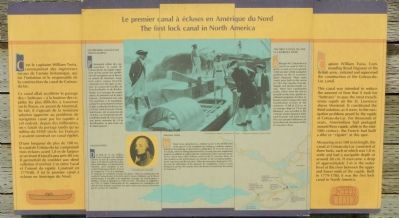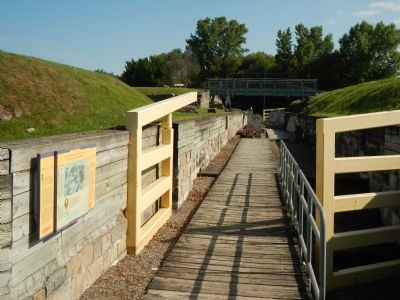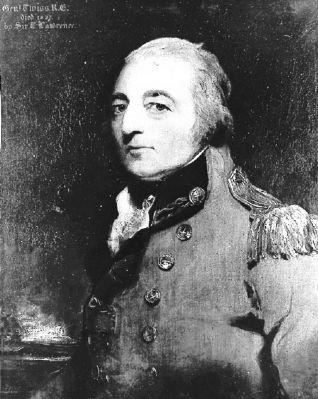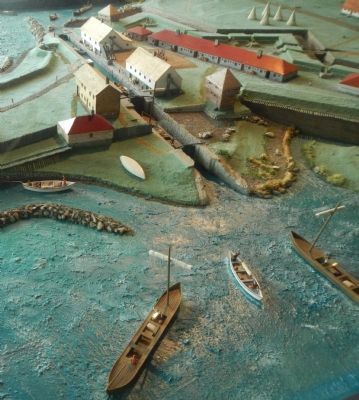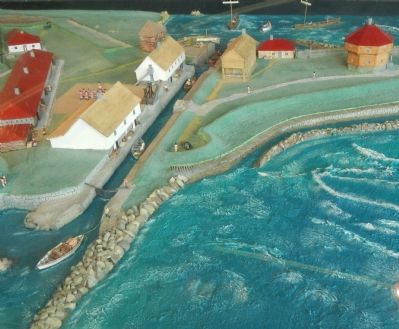Coteau-du-Lac in Vaudreuil-Soulanges, Québec — Central Canada (French-Canadian)
The first lock canal in North America
La premier canal à écluses en Amérique du Nord
Captain William Twiss, Commanding Royal Engineer of the British army, initiated and supervised the construction of the Coteau-du-Lac canal.
This canal was intended to reduce the amount of time it took for “batteaux” to pass the most treacherous rapids on the St. Lawrence above Montréal. It constituted the third solution, as it were, to the navigation problems posed by the rapids at Coteau-du-Lac. For thousands of years, Amerindians had portaged around these rapids, while in the mid-18th century, the French had built a dike or “rigolet” at this spot.
Measuring over 100 m in length, the canal at Coteau-du-Lac consisted of three locks, each of which was 1.8 m wide and had a navigable depth of around 80 cm. It overcame a drop of approximately 2 m in the water level of the river between the upper and lower ends of the rapids. Built in 1779-1780, it was the first lock canal in North America.
The first canals on the St. Lawrence River
Although the Coteau-du-Lac canal was used to full capacity as soon as it was opened, it did not solve all the navigation problems on the St. Lawrence above Montréal. Three more canals were built in this sector in 1783: the Faucille, Trou-du-Moulin and Rocher-Fendu canals. These four canalization works, which were the first to be built on the river, greatly facilitated navigation, for they allowed vessels to by pass the most troublesome section of the waterway. A fall of 25.6 m, or an average slope of 1.9 m per kilometre, was recorded in the 12.8-km section between lakes Saint-François and Saint-Louis. This was the greatest difference in level observed anywhere on the St. Lawrence River.
William Twiss
William Twiss embarked on a brilliant career in the British army at the age of 15. He completed his training as a military engineer during his first posting, to the Fortress of Bilgraltar (sic, Gibraltar). In 1776, he was sent to Canada, where he distinguished himself by carrying out many engineering projects. In addition to supervising the construction of the canal at Coteau-du-Lac and of three other military canals on the St. Lawrence River, he also worked on the fortifications of a number of sites including Québec, Sorel, Saint-Jean and Ile-aux-Noix. When he returned to England in 1783, he won the admiration of this superiors by completing a series of forts designed to protect his country from the threat of invasion by the armies of Napoleon.
French:
C’est le capitaine William Twiss, commandant des ingénieurs royaux de l’armée britannique, qui fut l’initiateur et le responsable de la construction du canal de Coteau-du-lac.
Ce canal allait accélérer le passage des «batteaux» à la hauteur des rapides les plus difficiles à traverser sur le fleuve, en amont de Montréal. En fait, il s’agissait de la troisième solution apportée au problème de navigation causé par les rapides à cet endroit: depuis des millénaires, on y faisait du portage tandis qu’au milieu du XVIIIᵉ siècle, les Français y avaient construit un canal rigole.
D’une longueur de plus de 100 m, le canal de Coteau-du-lac comprenait trois écluses ayant 1,8m de largeur et un triant d’eau d’à peu près 80 cm. Il permettait de combler un dénivellation d’environ 2m entre l’aval et l’amont du rapide. Construit en 1779-1780, il fut le premier canal à écluses en Amérique du Nord.
Les premiers canaux du Saint-Laurent
Pleinement utilisé des son ouverture, le canal de Coteau-du-lac ne réglait cependant qu’une partie des problèmes de navigation sur le fleuve, en amont de Montréal. Aussi, trois autres canaux furent-ils construits en 1783 dans ce secteur: les canaux de Faucille, de Trou-du-Moulin et de Rocher-Fendu. Ces ouvrages de canalisation, les premier sur le Saint-Laurent, constituaient une aide très précieuse à la navigation, puisqu’ils surmontaient la section le plus accidentée du fleuve. Entre le lac Saint-Francois et le lac Saint-Louis, soit un parcours de 12,8 km, on enregistrait une dénivellation totale 25,6 m avec une pente moyenne de 1,9 m du kilomètre, le plus forte sur le Saint-Laurent.
William Twiss
Dès l’áge de 15 ans, William Twiss entreprit une brillante carrière au sien l’armée britannique. C’est dans le cadre de sa première affectation, à la forteresse de Gibraltar, qu’il complèta sa formation d’ingénieur militaire. Envoyé au Canada en 1776, il se distingua en réalisant de nombreux travaux de génie. Outre la construction du canal de Coteau-du-lac et de trois autres canaux militaires sur le fleuve Saint-Laurent, il travailla de de nombreux ouvrages de fortifications, à Québec, à Sorel, à Saint-Jean et à l’Île-aux-Noix. De retour en Angleterre, en 1783, il s’attira l’admiration de ses supérieurs en complétant une série de forts destinés à protéger son pays contre une menace d’invasion par les armées de Napoleon.
Topics. This historical marker is listed in these topic lists: Forts and Castles • War of 1812 • Waterways & Vessels. A significant historical year for this entry is 1783.
Location. 45° 17.228′ N, 74° 10.574′ W. Marker is in Coteau-du-Lac, Québec, in Vaudreuil-Soulanges. Marker can be reached from Chemin du Fleuve close to Rue du Fort, on the left when traveling south. Touch for map. Marker is at or near this postal address: 307 Chemin du Fleuve, Coteau-du-Lac QC J0P 1B0, Canada. Touch for directions.
Other nearby markers. At least 8 other markers are within walking distance of this marker. Why a canal at Coteau-du-Lac? (here, next to this marker); The “rigolet” canal (a few steps from this marker); The construction of the canal (a few steps from this marker); The Coteau-du-Lac rapids (within shouting distance of this marker); A supply centre / Un poste de ravitaillement (within shouting distance of this marker); Changes in the landscape (within shouting distance of this marker); A canal excavated in the rock (within shouting distance of this marker); What is a lock canal? (within shouting distance of this marker). Touch for a list and map of all markers in Coteau-du-Lac.
More about this marker. This marker is located at Coteau-du-Lac National Historic Site.
Also see . . . William Twiss - Dictionary of Canadian Biography. During the years 1777–83 Twiss was also engaged in a wide variety of works at important points (among them, Quebec, Sorel, Île aux Noix, St Johns, and Montreal) involving hospitals, windmills, storehouses, barracks, fortifications, roads, bridges, prisons, ironworks, dams, and bakeries; he was involved as well in plans for various posts throughout the province. (Submitted on May 29, 2015, by Barry Swackhamer of Brentwood, California.)
Credits. This page was last revised on June 16, 2016. It was originally submitted on May 29, 2015, by Barry Swackhamer of Brentwood, California. This page has been viewed 440 times since then and 16 times this year. Photos: 1, 2, 3, 4, 5. submitted on May 29, 2015, by Barry Swackhamer of Brentwood, California. • Andrew Ruppenstein was the editor who published this page.
